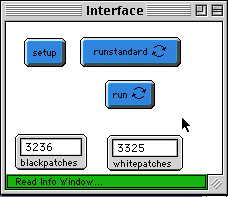
WHAT IS IT? ----------- This project depicts a simple cellular automata model that simulates voting distribution by having each patch take a "vote" of its eight surrounding neighbors and itself, then change its own vote according to the outcome. A vote of black counts as zero while a vote of white counts as one. HOW TO USE IT ------------- Click the SETUP button to create an approximately equal but random distribution of white and black patches. Click RUNSTANDARD to run according to traditional voting rules. That is, the central patch changes its color to match the majority vote. RUN follows a slightly different rule: near losses are awarded to the loser. That is, if five patches vote for white, the central patch becomes black; and if five vote for black, the central patch beomes white. The other possible voting combinations are awarded traditionally. Note that RUN and RUNSTANDARD can be run in alternation by having both buttons turned on at once! THINGS TO NOTICE ---------------- Watch how any setup quickly settles to a static state when using RUNSTANDARD. Also watch what happens when using RUN. Does the model settle to a pattern or to a particular shape? What happens when both buttons are depressed? EXTENDING THE MODEL ------------------- Try other voting rules. Start with a nonrandom black-and-white pattern. For example, one could make half of the screen white and half black by typing "ifelse xcor > ycor [setvote 0] [setvote 1]" into the command center. Can you enhance the model to incorporate multiple colors and multiple votes? One might interpret shades of color to represent the degree of a patch's opinion about an issue: strongly against, against, neutral, etc. Each patch could have more than two choices and weighted votes: blue patches' vote could count twice, etc. CREDITS AND REFERENCES ---------------------- This model is described in Rudy Rucker's "Artificial Life Lab", published in 1993 by Waite Group Press, PAGE ....